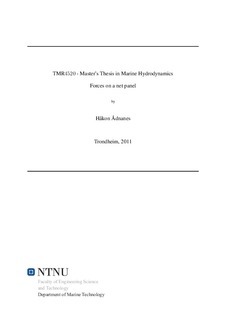| dc.description.abstract | Four different methods for calculating forces on and deformation of a net suspended in current have been compared.
The four methods are: 1) The method presented by Løland in his PhD thesis. Uses drag and lift coefficients based on experimental values. A zero moment requirement, and iteration is used to find the deformation and forces on net elements. 2) The solution of the catenary equation adapted to a net problem. 3) FhSim, a simulation software under development by SINTEF. Finds forces by adding contributions on single twines, based on coefficients from the modified cross flow principle. 4) AquaSim by Aquastructures, a commercial analysis software package. Forces on nets found from single twine contribution. A brief presentation of the different methods is given, with a more detailed discussion of the catenary equation method.
The drag and lift coefficients are compared to experimental data. The Løland and catenary equation methods are generally closest to the experimental data. An error analysis of the catenary equation for four different solidity ratios showed decreasing relative error on drag force, lift force and end point angle with increasing current velocity. At current velocity above 0.6m/s, all these gave a relative error of 16% or less. The relative error of maximum tension increase with increasing current velocity.
The four methods are compared with respect to drag force, lift force, and deformation. This is done with gradual increase of current velocity (case 1), and gradual increase of solidity ratio (case 2). The catenary equation and Løland method gives consistently almost equal lift force. FhSim and AquaSim also give very similar results for lift force, but the values are considerable lower than those from the other two methods. In FhSim, the low lift force is supported by relative small net deformations. Deformations according to AquaSim are larger, but still lower than those given from Løland and the catenary equation.
The drag force from Løland, the catenary equation and FhSim are generally in the same range, with some partial exceptions. At relative high current velocity or solidity ratio, the drag force from AquaSim is found to be many times larger than those calculated from the other methods. Due to the drag force being calculated as contributions from every single twine, the proportionality with the projected area is reduced, leading to a significant overestimation at large deformations.
Drag coefficients in FhSim should be larger for net panels with a angle relative to the current less than 60°. The lift coefficients for panels with an angle above 45° should also be larger. The solidity and angle independent factor in Lølands drag formula should be reduced or neglected.
Some sort of shielding effect due to twines upstream should be implemented in AquaSim to reduce the overestimation of drag force at large net deformation.
The lift coefficients for the catenary equation are likely high. The method seems to be viable for aquaculture application. | nb_NO |
